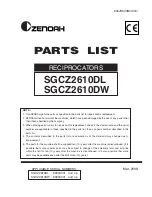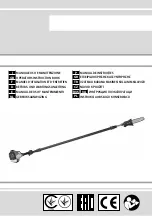
11
English
as well as proper operation of the saw. Check lower
guard for proper closing before each use as outlined
in
Further safety instructions for all saws
. If
the lower blade guard is missing or not working
properly, have the saw serviced before using. To assure
product safety and reliability, repair, maintenance and
adjustment should be performed by an authorized
service center or other qualified service organization,
always using identical replacement parts.
WARNING:
To minimize the risk of eye injury, always
use eye protection. Carbide is a hard but brittle
material. Foreign objects in the workpiece such as wire
or nails can cause tips to crack or break. Only operate
saw when proper saw blade guard is in place. Mount
blade securely in proper rotation before using, and
always use a clean, sharp blade.
WARNING:
To reduce the risk of injury, It is important
to support the work properly and to hold the
saw firmly to prevent loss of control which could
cause personal injury. Figure L illustrates typical
hand support.
WARNING:
To reduce the risk of serious personal
injury, read, understand and follow all important
safety warnings and instructions prior to using tool.
Blade Selection
Your circular saw is designed for use with 6-1/2" (165 mm)
diameter blades that have a 5/8" (15.9 mm) diameter bore.
Blades must be rated for 6000 RPM operation (or higher).
DO NOT use any abrasive wheels.
General Cuts
WARNING:
To reduce the risk of injury, remove the
battery, and follow all assembly, adjustment and set
up instructions.
Make sure lower guard operates. Select the proper blade for
the material to be cut.
• Measure and mark work for cutting.
• Support and secure work properly (refer to
Supporting
Large Panels/Securing Workpiece
).
• Use appropriate and required safety equipment (refer to
Additional Safety Information
).
• Secure and maintain work area (refer to
Safety
Instructions for All Saws
).
• With battery inserted, make sure switch turns saw on
and off.
Sawing
WARNING:
To reduce the risk of serious personal
injury, always hold the tool with both hands.
• Let the blade run freely for a few seconds before starting
the cut.
• Apply only a gentle pressure to the tool while
performing the cut.
• Work with the shoe pressed against the workpiece.
Hints for Optimum Use
• As some splintering along the line of cut on the top side
of the workpiece cannot be avoided, cut on the side
where splintering is acceptable.
• Where splintering is to be minimized, e.g. when cutting
laminates, clamp a piece of plywood onto the top of
the workpiece.
Pocket Cutting (Fig. A, M)
WARNING:
Never tie the blade guard in a raised
position. Never move the saw backwards when pocket
cutting. This may cause the unit to raise up off the
work surface which could cause injury.
A pocket cut is one that is made when the edge of the
material does not push the lower guard open, but the
bottom edge of the rotating blade cuts into the middle of
the material.
1. Adjust the shoe
5
so the blade cuts at desired depth.
2. Tilt the saw forward and rest front of the shoe on
material to be cut.
3. Using the retracting lever, retract lower blade guard to
an upward position. Lower rear of shoe until blade teeth
almost touch cutting line.
4. Release the blade guard (its contact with the work
will keep it in position to open freely as you start the
cut). Remove hand from guard lever and firmly grip
secondary handle
4
, as shown in Figure M. Position
your body and arm to allow you to resist kickback if
it occurs.
Fig. M
4
5. Make sure blade is not in contact with cutting surface
before starting saw.
6. Start the motor, allow saw to come to full speed, and
then gradually lower the saw until its shoe rests flat on
the material to be cut. Advance saw along the cutting
line until cut is completed.
7. Release trigger and allow blade to stop completely
before withdrawing the blade from the material.
8. When starting each new cut, repeat as above.
Содержание CMCS500
Страница 47: ......














































